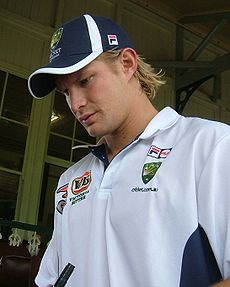How Australia turned around its one-day fortunes
Marco Trevisiol |
Last season it appeared the Australian one-day side was in steep decline. They were comprehensively outplayed by South Africa home and away and only managed a shared series at home to New Zealand (which they could easily have lost had rain not intervened in the deciding match). Overall, they won just 5 out of 14 matches in this period, one of their poorest runs in one-day cricket for years.
Australia were struggling to overcome the departure from their one-day line-up of Glenn McGrath, Andrew Symonds (although he did return briefly for a series against Pakistan), Matthew Hayden, Brad Hogg and Adam Gilchrist, all key elements of their dominant 2007 World Cup performance. The replacements (with the notable exception of Callum Ferguson) had generally struggled and it appeared a prolonged period of stagnation for the Australian one-day side lay ahead.
Yet, just a few months later, Australia had won 10 out of 11 one-day matches and taken out the Champions Trophy, the 2nd biggest one-day tournament behind the World Cup. What caused the substantial turnaround in form?
There are of course many factors that led to this turnaround but the return of Brett Lee and Shane Watson to the one-day side was as important as any.
Brett Lee’s achievements and skills in his one-day career have probably been underrated. For a career spanning a decade he has been Australia’s first choice new-ball bowler which, while a great opportunity for fast bowlers, also carries the great challenge of constantly facing ultra-aggressive batsmen looking to exploit field restrictions. It would be easy after being smashed around on occasion (as has occurred to Lee from time to time) to revert back to a more defensive style and pitch the ball short of a length but Lee has continued to adopt the mindset of a wicket-taker; pitching the swinging ball up and attempting to induce false attacking shots as well as bowling intimidating short deliveries.
This style of bowling has been enormously successful for Lee throughout his career as his stats show. From 185 matches he has taken 323 wickets at under 23. He has an outstanding strike rate of 29.2 and has been wicketless in an innings on only 31 occasions.
When Lee returned to the side for the start of the England one-day series he showed he was still a formidable new-ball bowler and was equally as impressive in the closing overs of innings. Lee’s successful return undoubtedly transformed the mental attitude of the other bowlers who knew they had a genuine spearhead that understood all the intricacies of being a successful one-day bowler as well as anyone. It was therefore no surprise that Lee’s return not only meant good bowling performances from him, but that the entire bowling line-up bowled as a cohesive, confident unit. Notably Lee managed to get at least one wicket in every match he played in England and at the Champions Trophy.
A one-day side is always in the match when they have a quality new-ball bowler that is feared by opponents and as long as Lee has been in the side, Australia has always had that.
The return of Shane Watson is perhaps even more significant. The best way to illustrate his importance is to compare him with Australia’s other all-rounder, James Hopes. Hopes ‘does a job’ for the side but in truth he’s no more than handy with bat or ball and not someone who has a major impact on matches, even in a format like one-dayers where all-rounders should prosper. That Hopes has yet to get a Man of the Match award in his 66 match career demonstrates this.
Whereas Hopes fills gaps in the side, Watson has added balance, depth and flexibility. On his batting alone he can justify a spot in the side with an average of over 40 from 90 matches. And even when he was struggling with the bat in the early stages of the Champions Trophy, he was still of enormous value because of his role as a bowler. Not just because he was bowling consistently well but because he was effectively the 6th bowler in the line-up which meant he could cover for one of the main bowlers who was having an off day.
But it is Watson’s batting that was of the greatest importance to the side. In the early stages of his one-day career he was mistakenly placed at 7 or 8 in the order, presumably because of the assumption that someone defined as an all-rounder shouldn’t be taking a spot usually reserved for a proper batsman.
But in reality putting Watson in the role of a slogger in the closing overs of an innings was a misuse and waste of his talents. As a batsman Watson has shades of the all-rounder he could potentially emulate, Jacques Kallis: a somewhat mechanical batting style that can get bogged down at times but when in form with his strong technique he can be a relentless and authoritative run accumulator. A spot somewhere in the top 4 where he can build an innings has always been where Watson is best suited.
After a patch of bad batting form with a succession of ducks, he demonstrated his best qualities with the bat in the semi-final and final of the Champions Trophy with contrasting performances. In the semi against England, he helped make what could have been a challenging chase a walk in the park with an aggressive and ruthless display. But his performance in the final against NZ was even more impressive. Chasing a modest target, Australia were suddenly highly vulnerable due to losing quick wickets, being down a batsman through injury and Cameron White looking shaky early on. If Watson had been dismissed within the first 20 overs Australia could’ve crumbled but through his strong technique and composure, he held his nerve and never looked like wilting even in the face of quality pace bowling. Through him Australia was able to see off the intense pressure cruise to a comfortable victory with Watson getting a well deserved century.
With Lee and Watson returning to the side in top form, Australia’s one-day line-up has been transformed from one treading water to one that has regained its aura as the best side going around.





Very good comparison between the batting styles of Watson and Kallis – although I don’t think Kallis has ever been quite the LBW candidate Watson has shown himself to be!
Comment by BD | 12:00am BST 20 October 2009
Good to see the blond boys getting their dues. Australia way more fun to watch when Lee and Watto are playing.
Comment by four_or_six | 12:00am BST 20 October 2009
Tbh I think the biggest change is in the teams they’ve played. Who have they beaten that they weren’t beating before?
The good thing about Australia, the thing that hasn’t changed with the retirement of so many great players, is their professionalism. You know what you’re going to get with the Aussies. When faced with a sub-standard England team, a crap West Indies team, a disinterested Pakistan team and New Zealand minus Vettori+Ryder, you can count on them not to screw up. Unlike, say, Pakistan.
I’d compare them to Roger Federer. No longer what they were, but still consistent enough to win the tournament when everyone else blunders somewhere down the line.
Comment by Uppercut | 12:00am BST 20 October 2009
Solid article. But TBH even when AUS where having a bit of trouble vs SA & NZ early this year, it was really all down to injuries anyway. So it shouldn’t be a real surprise that now that the ODI is back to full-strenght, that the solid perfromances have returned.
Comment by aussie | 12:00am BST 20 October 2009